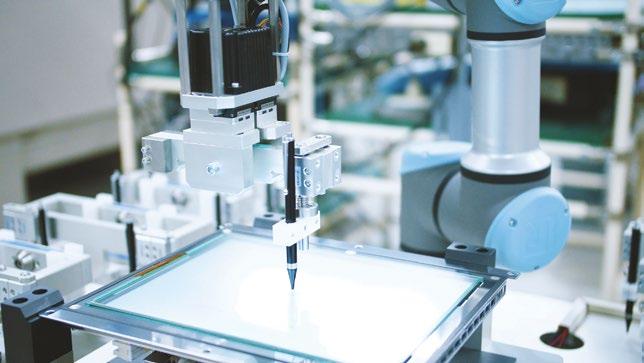
5 minute read
Protecting workers’ safety and wellbeing with collaborative
Protecting workers’ safety and wellbeing with collaborative robots
by James McKew, Regional President APAC, Universal Robots
Their value as an automation option is increasing.
Mr James McKew

Automation and robotics are often credited for their contribution towards achieving increased productivity and efficiency. Various sectors, especially manufacturing, construction and automotive, have relied heavily on industrial robots to achieve greater production output. Over the last 30 years, the capabilities of these large and bulky machines improved and transformed countless industrial processes. Built for sheer power and speed, the traditional industrial robots, however, presented safety risks to human workers. In recent years, global economic uncertainties and unprecedented crises have upended many aspects of life, from the way people live and their outlook on work, to the incorporation of new business models. This also means that the factors, that made a manufacturer successful, historically, have changed. The health and safety of employees have taken precedence over productivity and efficiency.
Reducing workplace injuries with cobots
According to the Workplace Safety and Health Report 2021, released by the Ministry of Manpower, there was a total of 12,766 workplace injuries reported in Singapore last year. Compared to the 11,350 workplace injuries reported in 2020, this was an 11% increase in the number of occupational injuries. In 2021, the top contributing sector/industry for major injuries in Singapore was the manufacturing sector, with 141 major injuries. These figures are high and the effects of accidents in workplaces are significant. Hence, manufacturers are radically changing their approach and providing employees with a safe working environment. The beliefs and factors that supported years of consistent growth may no longer be valid. This is where collaborative robots, or cobots, come in. Collaborative automation is changing the landscape and empowering employees. Unlike traditional industrial robots that require safety cages to keep employees out of the workspace, cobots are designed to work alongside human workers, without safety cages (upon risk assessment). Cobots have managed to unravel the general misconception that robots are dangerous. Recognised as the perfect man-machine collaboration, cobots are safe enough to function around human workers. For Koyo Electronics Industries, a manufacturer of electronics equipment, based in Japan, safety is given a high priority on the manufacturing floor. Accordingly,
Human operators working easily and safely alongside cobots.

the company decided on the deployment of cobots from Universal Robots (UR). The UR cobots feature safety functions such as protective stops. With built-in safety features, cobots can operate safely, without the installation of safety fences. This was a decisive factor in the choice of UR cobots by the Japanese company.
Cobots boost capacity and job satisfaction
While preventing workplace accidents is imperative, nurturing employees’ well-being is crucial in creating workplace resilience. Performing monotonous, repetitive tasks, such as heavy-lifting, loading and unloading, can lead to repetitive strain injuries. The deployment of cobots relieves human workers of these monotonous and strenuous tasks, freeing them to work on higher value activities that require the cognitive abilities of human beings. This was the case for BTC Mold, a Taiwan-based, ‘full-process’ manufacturer of plastic injection moulds. Initially, large machines were deployed at its production line. However, the manufacturer was faced with ongoing problems such as noise pollution as well as safety issues and space constraints, caused by the traditional automated equipment. Despite adopting automation solutions, ensuring the well-being of employees had become a challenge for BTC Mold. Before cobots were introduced, the packing of products was done manually. Human workers were required to bend over, when placing the products into boxes, causing joint pains and muscle aches, after a prolonged period of time. The introduction of UR cobots, by BTC Mold, relieved the workers from repetitive tasks, further reducing the risk of occupational
Why cobots are safe co-workers
Traditional industrial robotics still play an important role in manufacturing, but they are no longer the only option. In 2008, robot technology changed forever, with the introduction of collaborative robots (cobots). What is a cobot? For Universal Robots (UR), a cobot is a robot with Power and Force Limiting (PFL) safety functions contained within the robot that, ‘from the start’, have been designed to lessen risks. For example, UR robots have rounded surfaces and are designed without crushing points between moving parts of the robot arm. Cobots are smaller and easier to deploy than the industrial robots previously used, and cobots are specifically designed to be able to work alongside humans, safely.
Risk assessment performance
Performing a risk assessment for the intended use of robots, including cobots, and identifying foreseeable misuses is a global requirement. Risk assessment addresses these varying risks, to reduce the likelihood of workplace injuries.
Advanced technology to reduce safety risks
Technology is readily available to improve robot safety. In the case of PFL cobots, for example, with the PFL safety functions, the speed and motions of the cobots can be limited, and the operation stopped upon detection of contact.
Products certified to safety standards
All reputable robot manufacturers and integrators embrace their responsibility to deliver safe products and solutions, as described in the safety standards. They invest a significant amount of time to ensure their robots meet safety compliance standards (ISO 13849accidents caused by extensive periods of hard labour. Now, 11% of the company’s manufacturing processes are supported by UR cobots. The manufacturer has solved work environmental issues and created safe working conditions for employees, with the introduction of cobots. Manufacturing-related jobs often involve dull, dirty or dangerous tasks, potentially leading to workplace injuries and serious health complications. Such accidents can be significantly reduced. Collaborative automation has become increasingly capable of mitigating safety risks and improving employees’ well-being. Gone are the days when monotonous and repetitive tasks are conducted manually by humans. The use of cobots is an accessible automation option. It is here to stay and offers manufacturers a safe solution.
1 and ISO 10218-1). Although ISO 10218-1:2011 requires only two safety functions (emergency stop and safeguard stop), some manufacturers take safety to the next level. For example, UR’s cobots include 17 configurable safety functions certified by TÜV Nord as PLd Cat 3. This means that UR cobots have configurable limits for stopping time and stopping distance, joint position, pose, tool orientation, safety planes, safety boundaries, safe home (typically used for mobile applications), and forces. There are advanced capabilities for the Tool Centre Point (TCP) and elbow – TCP force limiting and elbow safety (force, speed and boundary restriction).
Societal benefits
Combining the efforts of both humans and robots offers significant opportunities to improve productivity, safety and overall workplace satisfaction.





